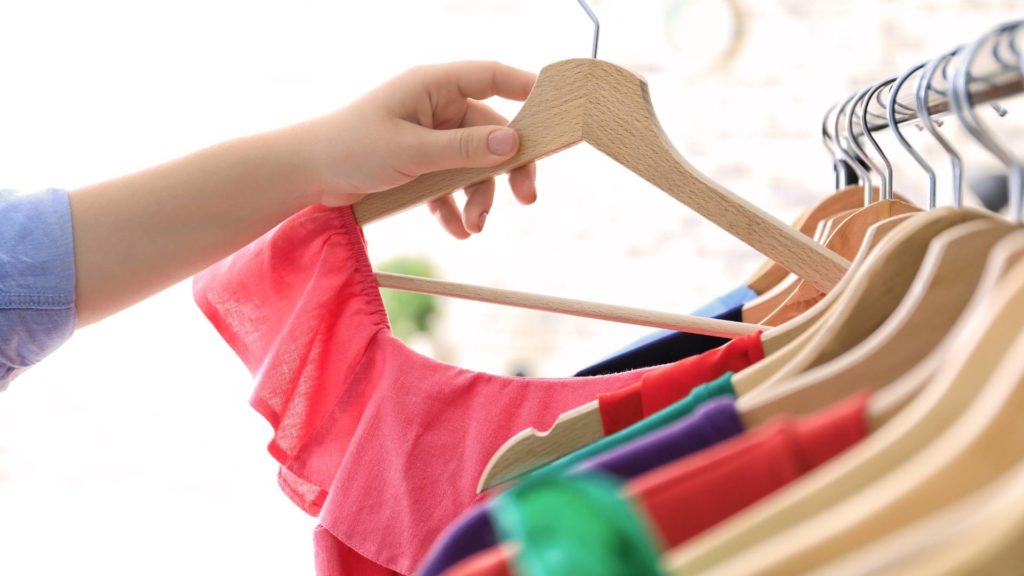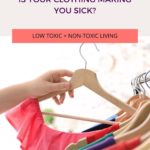A question we all need to take the time to investigate…is your clothing making you sick?
When you purchase clothing, you typically never even consider how it’s made. You may not realize that what is in your clothing may be a trigger contributing to making you sick.
I would like you to explore with me: why clothing can be problematic and how to choose better options. Knowledge is power, and I want to help empower you rather than cause you to feel overwhelmed.
There are several things to consider in buying “healthier” clothing which we will talk about in the article below: Chemicals in Textile production, Understanding Toxic vs Healthy Fibers, Reading Labels & Washing Instructions, and Circularity. All of these play a role in how many toxic chemicals you are coming into contact with through your clothes.
Chemicals in the Production of textiles
There is a lot to consider when buying clothes. Take cotton, for example:
- What kind of seed was used to grow that cotton? Was it a GMO seed?
- How was the fiber processed? Was the process laden with chemicals?
- Where is the garment produced? If from overseas, pollutants are added.
- Standard in production in other places may be different (and lower) than in the USA
- How is the garment made?
- How many chemicals are used to keep it looking nice in the store? Clothing is often sprayed with sizing agents and formaldehyde to keep the clothing looking good in the store.
- Are perfumes and air fresheners added to clothing in stores and warehouse storage?
Understanding Toxic vs Healthy Fibers
Be mindful of the fiber content of your clothing. Many fibers start out as natural but then are blended with synthetic fibers that are not biodegradable, made from petroleum byproducts. Polyester is a perfect example. Additionally, the microplastics in polyester, slowly over time, come off of the fabric and go into our waterways. They are so tiny that they can’t be filtered out. These plastics end up in the ocean, in the bellies of the fish, and eventually back in your body. Recycling plastic bottles to create polyester seems like a wonderful solution, but ultimately you have a microplastic issue. Here is a breakdown of what different fibers are made of:
- Nylon is a synthetic polymer that adds strength to fabrics.
- Rayon is a fiber that comes from cellulose (wood pulp, bamboo) but is processed into a fabric or yarn. The processing can be environmentally unfriendly.
- Cotton can be filled with chemicals if grown conventionally. However, there are a lot of great organic cotton options these days.
- Linen is a plant-based, wonderful, clean fiber. Production of linen does not require a lot of pesticides or water. Furthermore, organic labeling is unnecessary because it has low requirements for pesticides.
- Silk is also a very clean fiber. Cultivated worms can be used to make silk. In this process, the worm makes the cocoon and is then killed so you have the long fiber that makes beautiful silk. Peace Silk is another option, which can be cultivated or wild. With Peace silk, the worm is allowed to live and turn into a moth.
- Other fibers you might see on a label are animal fibers – wool, alpaca, cashmere, etc.
Animal fibers can be very warm, keep you warm when wet, and require less cleaning.
Reading Labels & Washing Instructions
You read a food label; why not read your clothing label? What you put in your body matters as much as what you put on it.
- Read the washing instructions.
- Read about the fibers the clothing is made from (for example, organic cotton, linen, and wool are more natural compostable fibers).
- Avoid clothing that is labeled as “dry clean only.” Dry cleaning uses neurotoxic chemicals. However, oftentimes when it says dry clean only, it can be machine washed, you just need to learn how to wash it properly.
There are two clothing certifications that let you know that an article of clothing holds a certain safe, clean status.
- Global Organic Textiles Standards (GOTS)
- Oeko Tex
These are worldwide leading textile processing standards for organic fibers, backed up by independent certification that will help guide your purchase. These certifications guarantee that it has been tested for harmful substances and there are no harmful substances.
Circularity
What is circularity? This is the ability of our clothing to be upcycled, have a longer than expected life, or to be easily compostable to return to the earth.
Discarded clothing often goes to a landfill. This fiber can sit in a landfill for a long time, unable to decompose and basically hurting the earth and all life that lives on it. Before you purchase a new garment, ask yourself “What happens when I’m done with it”?
Circularity gives your clothing a new life. With this mindset, you are constantly considering how that article of clothing will evolve and benefit someone else. For instance, the manufacture of jeans is a process that is laden with chemical pollution. However, one company found a clever way to use the shells left over from the food waste of shellfish to help adhere the die to the denim, as opposed to using harmful chemicals, which may be more easily compostable, although not entirely. By the same token, you can also fully compost an article of organic clothing.
Circularity is finding a way to keep the life-giving process evolving.
Bottom Line
Choose your clothing the way you do your food. Take the time to research and read labels. Be a conscious shopper and teach your children to do the same. Remember that what you put on your body can have just as powerful an impact as what you put in your body.
Recommended Brands and Sources
The cleanest brands:
Organic Cotton Plus (for Organic Cotton Thread)
Not totally clean, but much better than mainstream:
For more in-depth information about conscious living and clean products, please check out my Greening Your Home Masterclass.
Here’s what you will get with this incredible course:
- Greening Your Home Webinar Recording with Transcript
- Updated! Greening Your Home handout – new information & revised links, including new sections on radiation and mold
- Updated! Natural & Holistic Beauty Guide handout – new information & revised links, including all my newest finds!
- Brand New! Hanaan’s Emergency Kit handout – a list with links of my daughter’s super handy emergency kit that she takes with her everywhere she goes; you can model your own emergency kit after hers!
- Brand New! Ingredients to Avoid handout – I went in-depth into the top ingredients you need to avoid in your beauty and wellness products.
- Brand New! Skincare and Makeup Recorded Short Webinar – I recorded a short webinar where I share my knowledge about skincare and makeup products with you.
Navigating this toxic world can be overwhelming. It is my goal to remove the confusion and overwhelm. Please leave me a comment and let me know if you have found any other good, clean clothing brands. Let’s try to move forward living consciously and leading by example with the choices we make.
To your health & happiness,
Muneeza






